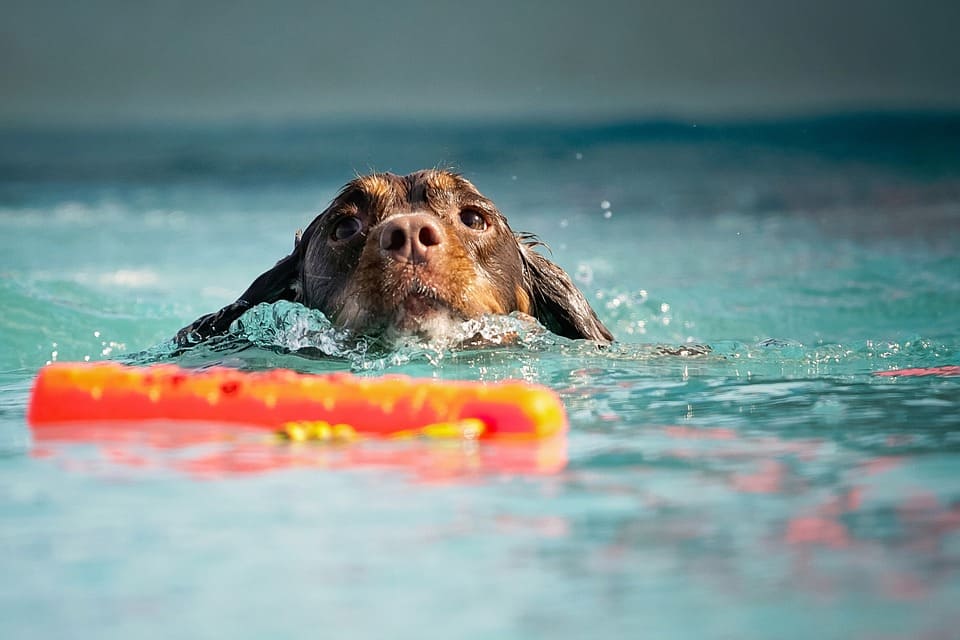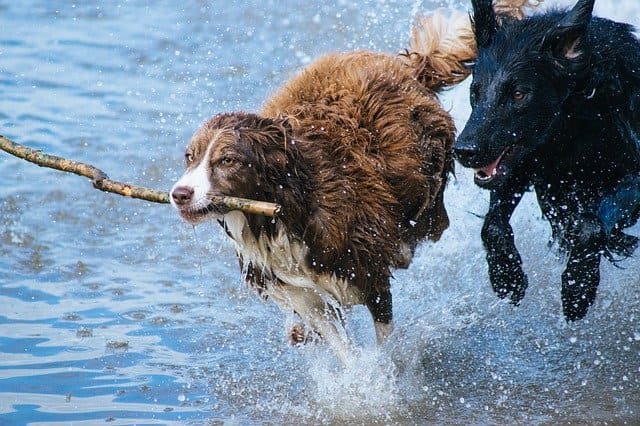On a hot day, nothing beats splashing in the cool water, for both humans and dogs. Even though they have their own swimming stroke (the dog paddle, of course), not all dogs are natural swimmers.
You and your dog can enjoy a nice swim in the local pool or a swimming hole if you prepare properly.

While you’re away, keep in mind that dogs are susceptible to heat stroke. Also, consider placing a GPS tracker on your dog’s collar so you can locate him anywhere.
- LOCALIZACIÓN GPS EN TIEMPO REAL: localiza a tu perro y sigue sus pasos, sin límite de distancia
Is it true that all dogs know how to swim?
Technically, any dog that enjoys excellent health and has been properly introduced to swimming can swim. Some dog breeds are natural swimmers, while others have body characteristics that are not well suited to this sport.
Of course, a dog’s ability to swim is determined not only by its breed, but also by its personality and life experiences.
Swimming-loving dog breeds
Since golden retrievers and Labrador retrievers were bred to retrieve waterfowl for hunters, they often feel at home in and around the water.
Spanish water dogs, Portuguese water dogs and American water spaniels have a natural fondness for water, as their names suggest.
Dog breeds that can’t swim
There are also some dog breeds that are not especially good swimmers. Basset Hounds, corgis, and dachshunds, for example, have short legs and long bodies and may have difficulty navigating deep water.
In addition, flat-faced dog breeds, such as pugs, French bulldogs, and Pekingese, may have difficulty breathing while swimming, as they must tilt their heads upwards to breathe. Swimming is difficult for bulldogs due to the natural distribution of their body weight.
Therefore, if you take any of these dogs into the water, do not forget to bring a canine life jacket.
No products found.
Is your dog a water lover?
Although a dog breed is known for its affinity for water, some dogs do not enjoy getting wet. Even if it’s simply wading ankle-deep, virtually any dog can learn to love water.
How to teach your dog to enjoy water
Make your dog’s first time in the water memorable. Check your dog’s interest in water on his first visit and if he follows you.
Let your dog decide how far he wants to get into the water. Stay close to him and congratulate him verbally. Your dogs may need a few visits to the water before they’re willing to get in. Just be patient and optimistic.
Another good place to start getting your dog used to being in the water is a plastic children’s pool. Choose a hard plastic children’s pool instead of an inflatable one, as the latter can be pierced by your dog’s toenails.
Fill the children’s pool with a few centimeters of water and place it in your garden. Let the water warm for an hour or two in the sun. The slippery surface of the children’s pool may not be suitable for your dog, so place some rubber mats on the pool floor to provide traction. Include some of your favorite toys. Keep an eye on your pet and reward him with food and praise every time he enters the water.
Throwing a ball into the sea and having your dog chase it to the waves is not a good way to start dog swim training. They don’t realize that the water is getting deeper or that they can be knocked down by a wave. Your dog may get scared and refuse to enter the water again.
To protect it, use a life jacket for dogs
It’s crucial to keeping your domestic friend safe. For each swim session, make sure your dog has properly fitted dog flotation equipment.
No products found.
A dog life jacket will give your dog confidence in the water and you the peace of mind that he is protected from harm. (A GPS tracker for dogs can also be a lifesaver when it comes to peace of mind.)
Low-fat dogs may benefit from a dog life jacket because they may have difficulty staying afloat. These thin-bodied dogs would have to work especially hard to keep their heads above water without a canine life jacket, and they would quickly fatigue.
Make sure your dog is wearing a life jacket made of waterproof materials and that it fits properly. If you’re in the lake with your dog, a life jacket with handle will allow you to pull him out of the water if he falls overboard.
A life jacket with a D-shaped ring is useful for holding a leash while walking your dog on the beach.
Don’t think that just because your dog is a water-loving breed he will be safe in the water without a life jacket. If left alone, any dog, especially in the ocean, could get into trouble.
Allowing your dog to swim unsupervised is never a good idea.
Choosing a bathing spot for you and your dog
There are numerous places where you can swim with your dog. The area you choose can be determined by your dog’s comfort level in the water, his own lifestyle, and the distance he is willing to travel.
Swimming in salt water with dogs
We’ve all seen photos of dogs riding a surfboard the size of a dog to catch a wave in the ocean. This is not what you expect on your first trip to the beach with your dog.
The ocean is a tremendous force to approach with caution, especially if it’s your first time going with your dog.
Start by walking along the shore (with your dog on a leash and wearing a life jacket). Watch the waves as they hit the beach. Seagulls, crabs, algae and humans will catch your dog’s attention. Take a couple of steps in the water up to your ankles and watch your dog’s reaction.
You may enjoy it or it terrifies you. Keep a positive visit by refusing to force your dog into the water and don’t trick him by throwing a ball into the water to chase her.
Dogs, just like humans, can be overwhelmed by currents, currents, and waves. In addition, consuming too much salt water can lead to various problems ranging from moderate diarrhea to death. When you’re at the beach, make sure your dog has access to fresh water.
Swimming in fresh water: safety for dogs in lakes and ponds
Lakes and ponds are ideal places to start your puppy in the water. The depth of the water increases progressively as you approach a lake or pond from the shore, so your dog will only be able to dive as much as he wants. While huge lakes can have powerful waves and currents, smaller lakes and ponds don’t.
Take your dog into the water after his feet are wet and he seems comfortable. You can also bring a canine companion and let your dog watch him swim in the lake.
Your dog may choose to participate in the fun. For the protection of your dog, remember to put on the life jacket.
During the summer, blue-green algae can grow in ponds and lakes in some regions. Blue-green algae, also known as cyanobacteria, can produce various symptoms, such as a small irritation of the eyes, vomiting, diarrhea, lethargy, and even death.
If the water is discolored, smells bad, has a lot of visible algae on the surface, or there are official green-blue algae notices, you and your dog should stay away from it.
Is it possible for your dog to bathe in a pool?
Under his supervision, backyard pools are often considered safe places for dogs to swim. Since most pools are too deep for a dog to stand, you may want to introduce your dog to the water until he feels comfortable.
Teach your dog where the pool exit points are so he knows them beforehand. A dog may not be able to locate the stairs or pool ramp on its own.
No products found.
Allowing your dog to bathe in the backyard pool can be a lot of fun for the whole family, but there are some drawbacks to consider.
Dogs have much more hair than humans, and that hair will end up in your pool’s filtration system. Dog hair often contains detritus, such as dirt, pollen and even feces, which can contaminate the pool. Dog nails can tear the pool lining and damage inflatable toys.

If you decide to let your dog bathe in your pool, be sure to brush and rinse him first. This will limit the amount of waste your dog puts into the pool.
Check if your local pool offers dog bathing days. Once the pool closes for people at the end of summer, many seasonal community pools host a dog bathing day.
Is it safe for dogs to bathe in a pool?
In a pool, everyone drinks some water, but don’t let your dog drink a lot. Stomach upset, diarrhea or vomiting may occur after drinking a considerable amount of pool water.
The chemicals used to keep pool water can irritate your dog’s skin and eyes, especially if he bathes frequently. To prevent itching and dry skin, give your dog a clean bath with the garden hose when you get out of the pool.
No products found.
Make sure dangerous pool chemicals, such as chlorine, are kept out of the reach of children and pets.
What temperature is too cold for dogs to bathe?
Swimming for long periods of time in water that is too cold can cause hypothermia in dogs, as well as in humans. Hypothermia is a dangerously low body temperature caused by the loss of heat from the body faster than it can produce.
Don’t leave your dog unattended
From swimming pools to oceans, all bodies of water can be dangerous for pets and people. Treat your dog like a toddler — don’t let him go near water or a pool unless you’re there to supervise him.
If your dog has access to a backyard pool, this includes letting him go outside to relieve himself. Instead of a floating cover, under which dogs and children can get trapped if they fall, your pool should have a safety cover.
Among the breeds of water-loving dogs is the golden retriever.
What are the advantages of your dog swimming?
Swimming is a great method for people to stay fit or heal from their injuries, and your dog can benefit from it too.
The pool is an excellent area to rehabilitate your dog if he has arthritis, dysplasia or a brace. Swimming is a low-impact, weight-bearing activity that puts no pressure on joints or tendons.
Warm water swimming can help relieve pain, blood flow, and injury rehabilitation. For your dog’s rehabilitation, talk to your veterinarian about hydrotherapy, and s Ideal for overweight dogs.
Overweight or obese dogs have difficulty moving on land. Swimming allows overweight dogs to be more active, while reducing the danger of them straining or injuring themselves. Swimming, along with dietary adjustments, can help large dogs lose weight.
According to experts, one minute of swimming is equivalent to four minutes of running. Swimming improves circulation and aerobic capacity.
Another advantage of taking your dog swimming is that it can help relieve stress and improve overall health. Swimming allows them to interact with you, their favorite person, while allowing them to move freely and off a leash. Active dogs become exhausted and need restful sleep, which is essential for optimal health.
After swimming, take care of your dog
The unpleasant smell of “wet dog” is one of the dangers of water games. When your dog has finished swimming, give him a good rinse, towel drying, and brush him thoroughly. Dry your dog’s ears thoroughly to prevent them from becoming infected, especially in lop-eared dogs, such as Labradors. Check if your dog has ticks or cuts.
Swimming is a strenuous activity, so give your dog plenty of fresh water and maybe a treat afterward.
Spread a blanket in the shade and enjoy a well-deserved nap once your dog is clean, dry and exhausted after bathing.
Do you help us share?

Why do you need to brush your dog’s teeth daily?

Can my dog suffer from heat stroke?

Leishmaniasis in dogs

Muzzle

Home remedies for shedding hair in dogs

How to remove dog piss odor
- Why do dogs bury bones? - January 2, 2023
- How long is a dog’s pregnancy? - December 24, 2022
- Why do dogs mark territory? - October 24, 2022


